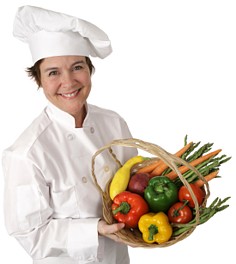Organizing Recipes
Cooks’ favorite recipes usually come from a variety of sources, so organizing recipes for fast and easy access can become a problem. People who collect recipes may have materials garnered from a wide variety of sources: cooking programs on television, friends, cookbooks, magazines, newspapers, store fliers, store handouts, and Internet searches. Here are some tips for organizing recipes using a variety of approaches. Use the system that works best for you.
Recipe File
If you like to have all your recipes in one place, there are small 3”x 5” (7.62 x 12.7 cm) index boxes and cards to fit them specifically designed for recipes. Sometimes the cards are actually 7” x 5” (17.78 x 12.7 cm) with a fold at the bottom, allowing more room for recording recipes. The boxes have food-related designs, and the cards may have preprinted spaces for oven temperature, number of servings, and a list of ingredients. You can also choose to use a larger box size, if you often find that you run out of space on the smaller cards. Many web sites offer printing services in a variety of sizes, including full page, 3” x 5” (7.62 x 12.7 cm) and 4” x 6” (10.16 x 15.24 cm).
Category or alphabetical dividers are available, which allow organizing recipes by foods in classes like “breads,” “salads,” “cookies,” “pork,” or in alphabetical order. You can also add your own categories or create a set from scratch, using write-on dividers. If you need an entire section for, say, “curries” or “legumes,” you can go ahead and create it. You can also create a section for your most used recipes. Some people find this the handiest way to store recipes because the card boxes are small and portable. If you have a large number of recipes, you can have multiple boxes with major divisions like “desserts” and “main dishes” and “side dishes.” The recipe box can serve as a collection center for recipes drawn from anywhere and arranged to suit you.
Another kind of recipe file is a larger box with proprietary cards delivered by a manufacturer. This kind of set is often offered with a monthly subscription. This is the way some people acquire recipes, and the organization is usually well-thought out and done for you. However, if you have a more eclectic approach, you can also add recipes from other sources to the box.
 A third approach is the on-line recipe box. Some food and cooking websites allow you to add recipes from the site to an on-line recipe box. This cuts down on storage space in your home, and allows you to group and sort recipes in a variety of ways.
A third approach is the on-line recipe box. Some food and cooking websites allow you to add recipes from the site to an on-line recipe box. This cuts down on storage space in your home, and allows you to group and sort recipes in a variety of ways.
If the box is not your favorite approach, punch holes in the corners, and put them on loose-leaf rings.
Binder
Another approach to organizing recipes into a single system is to use binders, like the type used for school and fill them with pages that are cut (if from magazines, newspapers, fliers, etc.) or scanned (from recipe books) or printed (from the Internet). Full size pages can be hole-punched, or all pages can be placed back to back in plastic sheet protectors. As with recipe file boxes, dividers can be used to create categories, and recipes can be organized within those categories. For large collections, multiple binders can be used.
Software
Recipe software is available for those who wish to build their own collection on their computer. All your recipes can be collected in one place, and organized as you desire, with the ability to search through them in a variety of ways (for example, by cuisine, by occasion, by a particular ingredient). Some programs will create a shopping list based on your recipes or find recipes that have a specific ingredient list. They may come with recipes and also allow you to add your own.
You can also go about organizing recipes by creating your own database in a database program. This approach is similar to that above, but is probably cheaper and lets you limit the collection to your own recipes. You can set it up to sort by categories that you choose. Unless you are particularly skilled in database construction, it may not have as many features as the specific recipe software offered for sale.
Index
If you don’t have a wish to centralize all your recipes, you can combine one of the schemes above with an index that identifies the recipe and location, whether it is in a cookbook, a cooking magazine, on-line, or in your recipe box or binder. This index can be handwritten or created in a word processing or database program to make it possible to sort it in various ways.
Laminated Sheet
If you have recipes you make over and over again, one approach to keeping them handy is to write or type them on a page or two (single or double-sided, as you wish), laminate them, and hang them in your kitchen or place them in a drawer. Lamination will render them durable and stain resistant.
Written by Mary Elizabeth
